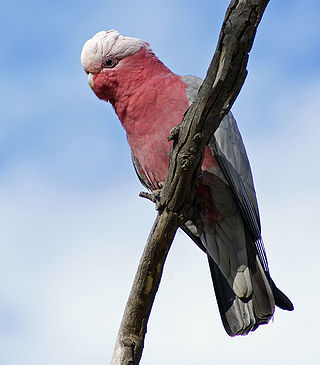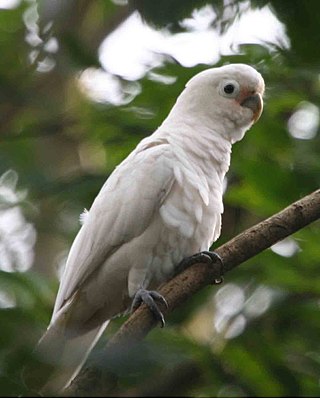
Grebes are aquatic diving birds in the order Podicipediformes. Grebes are widely distributed freshwater birds, with some species also found in marine habitats during migration and winter. Most grebes fly, although some flightless species exist, most notably in stable lakes. The order contains a single family, the Podicipedidae, which includes 22 species in six extant genera.

A cockatoo is any of the 21 species of parrots belonging to the family Cacatuidae, the only family in the superfamily Cacatuoidea. Along with the Psittacoidea and the Strigopoidea, they make up the order Psittaciformes. The family has a mainly Australasian distribution, ranging from the Philippines and the eastern Indonesian islands of Wallacea to New Guinea, the Solomon Islands and Australia.

The Tanimbar corella, also known as Goffin's cockatoo, is a species of cockatoo endemic to forests of Yamdena, Larat and Selaru, all islands in the Tanimbar Islands archipelago in Indonesia. It has been introduced to the Kai Islands, Indonesia, Puerto Rico and Singapore. This species was only formally described in 2004, after it was discovered that the previous formal descriptions pertained to individuals of a different cockatoo species, the Ducorps' or Solomons cockatoo. Tanimbar corellas are the smallest of the white cockatoos. It is classified as Near Threatened due to deforestation and bird trade. It breeds well in captivity and there is a large avicultural population.

The cockatiel, also known as the weero/weiro or quarrion, is a medium-sized parrot that is a member of its own branch of the cockatoo family endemic to Australia. They are prized as household pets and companion parrots throughout the world and are relatively easy to breed. As a caged bird, cockatiels are second in popularity only to the budgerigar.

Major Mitchell's cockatoo, also known as Leadbeater's cockatoo or the pink cockatoo, is a medium-sized cockatoo that inhabits arid and semi-arid inland areas of Australia, though it is seen regularly in other climates, for example, South-East Queensland's subtropical region.

The salmon-crested cockatoo, also known as the Moluccan cockatoo, is a cockatoo endemic to the Seram archipelago in eastern Indonesia. At a height of up to 46–52 centimetres (1.51–1.71 ft) and weight of up to 850 grams (1.87 lb), it is among the largest of the white cockatoos. The female is slightly smaller than the male on average. It has white-pink feathers with a definite peachy glow, a slight yellow on the underwing and underside of the tail feathers and a large retractable recumbent crest which it raises when threatened, revealing hitherto concealed bright red-orange plumes to frighten potential attackers. It may also be raised in excitement or in other 'emotional' displays. Some describe the crest as "flamingo-colored". It also has one of the louder calls in the parrot world and in captivity is a capable mimic.

The galah, also known as the pink and grey cockatoo or rose-breasted cockatoo, is the only species within genus Eolophus of the cockatoo family. Found throughout Australia, it is among the most common of the cockatoos. With its distinctive pink and grey plumage and its bold and loud behaviour, it is a familiar sight in the wild and increasingly in urban areas. It has adapted well to urban expansion, and appears to be replacing the Major Mitchell's cockatoo in parts of its range.

The white cockatoo, also known as the umbrella cockatoo, is a medium-sized all-white cockatoo endemic to tropical rainforest on islands of Indonesia. When surprised, it extends a large and striking head crest, which has a semicircular shape. The wings and tail have a pale yellow or lemon color which is exposed when they fly. It is similar to other species of white cockatoo such as yellow-crested cockatoo, sulphur-crested cockatoo, and salmon-crested cockatoo, all of which have yellow, orange or pink crest feathers instead of white.

The sulphur-crested cockatoo is a relatively large white cockatoo found in wooded habitats in Australia, New Guinea, and some of the islands of Indonesia. They can be locally very numerous, leading to them sometimes being considered pests. A highly intelligent bird, they are well known in aviculture, although they can be demanding pets.

The Solomons cockatoo, also known as the Ducorps's cockatoo, Solomons corella or broad-crested corella, is a species of cockatoo endemic to the Solomon Islands archipelago. This small white cockatoo is larger than the Tanimbar corella yet smaller than the umbrella cockatoo. The species is common across most of the Solomons, absent only from Makira in the south. It inhabits lowland rainforests, secondary forests, cleared areas and gardens.

The gang-gang cockatoo is a parrot found in the cooler and wetter forests and woodlands of Australia, particularly alpine bushland. It is the only species placed in the genus Callocephalon. Mostly mild grey in colour with some lighter scalloping, the male has a red head and crest, while the female has a small fluffy grey crest. It ranges throughout south-eastern Australia. The gang-gang cockatoo is the faunal emblem of the Australian Capital Territory. It is easily identified by its distinctive call, which is described as resembling a creaky gate, or the sound of a cork being pulled from a wine bottle.

Described by French naturalist Anselme Gaëtan Desmarest in 1826, the genus Calyptorhynchus has two species of cockatoos. They are all mostly black in colour, and the taxa may be differentiated partly by size and partly by small areas of red, grey, and yellow plumage, especially in the tail feathers. Studies based on the mitochondrial DNA 12S gene fragment suggested that other sexually dichromatic species, the gang-gang cockatoo and the cockatiel may be the closest living relatives of Calyptorhynchus. However, subsequent studies, including more genes confirm the morphological taxonomy with the gang-gang cockatoo most closely related to the galah, within the white cockatoo group, and with the cockatiel as a third distinct subfamily of cockatoos.

Parrots, also known as psittacines, are birds of the roughly 398 species in 92 genera comprising the order Psittaciformes, found mostly in tropical and subtropical regions. The order is subdivided into three superfamilies: the Psittacoidea, the Cacatuoidea (cockatoos), and the Strigopoidea. One-third of all parrot species are threatened by extinction, with higher aggregate extinction risk than any other comparable bird group. Parrots have a generally pantropical distribution with several species inhabiting temperate regions in the Southern Hemisphere, as well. The greatest diversity of parrots is in South America and Australasia.

A caruncle is defined as 'a small, fleshy excrescence that is a normal part of an animal's anatomy'. Within this definition, caruncles in birds include wattles, combs, snoods, and earlobes. The term caruncle is derived from Latin caruncula, the diminutive of carō, "flesh".
Ranger Red's Zoo & Conservation Park, formerly Peel Zoo, is a zoo and wildlife sanctuary located on the banks of the Murray River in Pinjarra, Western Australia. It is a member of the Zoo and Aquarium Association.

The Triton cockatoo is one of the four subspecies of the sulphur-crested cockatoo. The cockatoo was first described by Dutch zoologist, Coenraad Jacob Temminck, in 1849. There is no documentation as to why Temminck selected this name however it is suggested that it was named after the Dutch corvette, Triton, which operated off the Dutch New Guinea coastline, in 19th century.





























